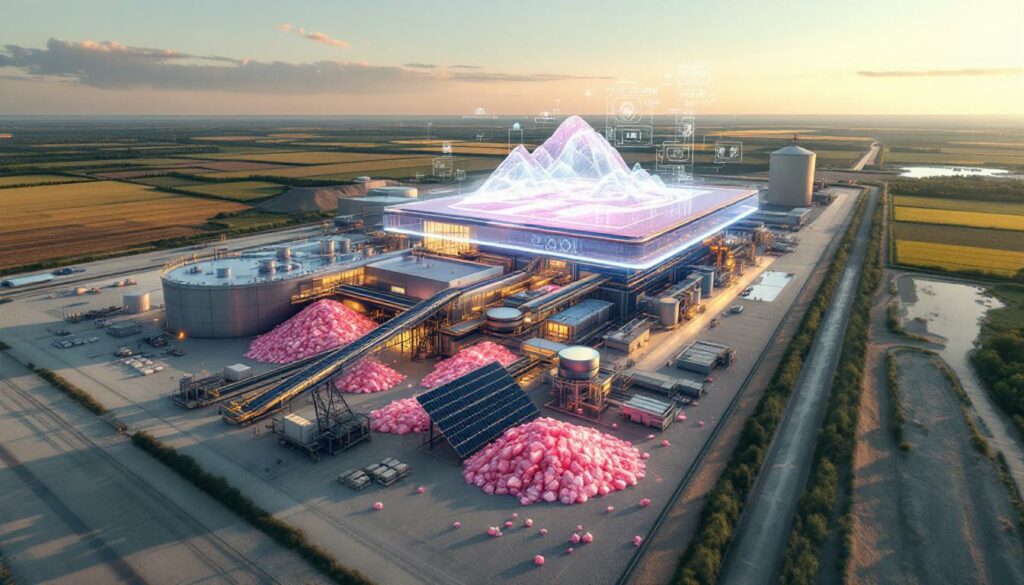What is BHP's Jansen Potash Project?
BHP's Jansen Potash Project represents a transformative investment in global fertilizer production, currently standing at over 60% completion with first production scheduled for late 2026. This massive undertaking requires a $10.6 billion investment, making it Canada's largest private sector project and positioning it to become one of the world's most significant potash operations.
Located in Saskatchewan's potash-rich basin, the project is strategically positioned to leverage the region's vast mineral resources. Once fully operational, Jansen is expected to supply approximately 10% of global potash demand, fundamentally altering the landscape of fertilizer production worldwide.
BHP CEO Mike Henry has described Jansen as a "world-class asset with strong long-term fundamentals and expansion potential," underscoring the company's confidence in its transformative role in the potash market.
The Scale and Significance of the Project
The sheer magnitude of the Jansen project cannot be overstated. At $10.6 billion, this investment represents not just BHP's commitment to diversifying its portfolio beyond traditional mining operations but also a significant vote of confidence in potash as a critical mineral for global food security.
Saskatchewan's rich potash deposits make it an ideal location for such a massive undertaking. The province already accounts for approximately 30% of global potash production, and BHP's Jansen potash project in Saskatchewan will further cement its position as a world-leading supplier of this essential agricultural nutrient.
What makes this project particularly notable is its capacity to reshape global supply chains. By introducing a new major player into a market historically dominated by a handful of producers, Jansen creates potential for improved price stability and supply security for agricultural producers worldwide.
Key Technical Innovations
What truly sets Jansen apart is BHP's commitment to implementing cutting-edge technology throughout the operation. The company has emphasized that the mine will be "remotely operated" and "far cleaner than older sites," representing a significant advancement in modern mining technology.
Remote operation capabilities will allow BHP to maintain precise control over extraction processes while minimizing personnel requirements in challenging underground environments. This approach not only improves safety but also optimizes operational efficiency through consistent, computer-controlled mining parameters.
The project's environmental innovations represent a step-change in potash mining. Traditional potash operations often face challenges related to water usage, energy consumption, and waste management. BHP's "cleaner" approach likely incorporates reduced water requirements, energy-efficient processing methods, and improved tailings management systems.
Advanced safety systems will be integrated throughout the operation, leveraging real-time monitoring technology to identify potential hazards before they become critical. This proactive approach to safety aligns with BHP's global commitment to zero harm in its operations.
How Will Jansen Impact the Global Potash Market?
As one of the world's largest potash mines upon completion, Jansen is poised to fundamentally alter global fertilizer dynamics. By introducing significant new supply capacity—approximately 10% of global demand—this single project could reshape market dynamics that have historically been dominated by a small number of major producers.
The project's impact will likely extend beyond simple supply increases. BHP's entry into the potash market brings a new major player with deep financial resources and global logistics expertise, potentially introducing new competitive dynamics to a relatively consolidated industry.
Production Capacity and Market Influence
Jansen's projected output will position it among the world's largest potash operations. The mine's initial production capacity represents just the beginning, with substantial expansion potential built into the project's design and infrastructure.
The strategic timing of Jansen's development coincides with growing global concerns about fertilizer supply security. Recent geopolitical events involving Russia and Belarus—two major potash producers—have highlighted vulnerabilities in the global supply chain. BHP's entry provides an important alternative source from a politically stable jurisdiction.
BHP's positioning as a low-cost producer could also influence broader pricing dynamics within the market. The company's emphasis on operational efficiency and technological innovation may establish new benchmarks for production costs, potentially creating competitive pressure on existing producers with older, less efficient operations.
Economic Benefits for Saskatchewan
The economic ripple effects of Jansen extend throughout Saskatchewan's economy. During the construction phase alone, the project has created thousands of jobs across various trades and specialties, with more permanent positions to follow during operational phases.
Local businesses throughout the supply chain benefit from procurement opportunities, from specialized mining equipment to everyday operational supplies. This economic stimulus extends well beyond the immediate project area, supporting communities throughout the province.
Tax revenue generation represents another significant benefit. Provincial and federal governments will receive substantial tax proceeds from the operation, providing funds for public services and infrastructure development that benefit all residents.
The project also drives infrastructure improvements that benefit the broader community, including road upgrades, power distribution enhancements, and telecommunications advancements that serve areas beyond the mine site itself.
What Makes Jansen Different From Other Potash Operations?
BHP has positioned Jansen as a fundamentally different kind of potash operation, emphasizing its modern design principles focused on efficiency, sustainability, and technological advancement. According to BHP, the mine will be "low-cost, remotely operated, and far cleaner than older sites"—a trifecta of advantages over traditional potash operations.
This differentiation is critical in an industry where many existing operations were designed and built decades ago, often with less consideration for environmental impacts and technological integration than would be expected today.
Environmental and Sustainability Features
Jansen's environmental profile represents a significant advancement over conventional potash mining. While specific metrics aren't publicly detailed, the "far cleaner" designation likely encompasses several key sustainability transformation improvements:
The operation likely employs a substantially reduced carbon footprint through electrification of mining equipment, efficient processing techniques, and renewable energy integration where feasible. These measures align with BHP's broader climate commitments.
Water consumption—traditionally a significant concern in potash processing—has likely been addressed through closed-loop systems, advanced water recovery techniques, and process optimizations that minimize freshwater requirements.
Surface disturbance has been minimized through innovative mine design that concentrates surface facilities and infrastructure within a smaller footprint than comparable operations. This approach preserves more natural habitat and agricultural land.
Energy efficiency measures have been implemented throughout the operation, from efficient motors and drives to heat recovery systems and optimized ventilation controls that reduce overall energy consumption.
Technological Advancements
Jansen's technological approach represents a step-change in potash mining operations:
Automation and remote operation capabilities significantly reduce on-site personnel requirements, improving both safety and operational consistency. Remote operators can monitor and control multiple pieces of equipment simultaneously, optimizing productivity while reducing exposure to underground hazards.
Digital twin modeling—creating virtual replicas of physical assets—allows for predictive maintenance and operational optimization. By monitoring equipment performance in real-time and comparing it against expected parameters, potential issues can be identified and addressed before they cause significant disruptions.
Advanced modelling techniques maximize resource recovery rates, ensuring more potash is extracted from each ton of ore brought to the surface. This improves both economic returns and resource stewardship.
Real-time environmental monitoring systems ensure continuous compliance with regulatory requirements and provide immediate alerts if any parameters approach threshold limits. This proactive approach to environmental management reduces risks of non-compliance events.
What Are BHP's Long-Term Plans for the Project?
BHP CEO Mike Henry has described Jansen as having "strong long-term fundamentals and expansion potential," indicating that the current development represents just the beginning of BHP's potash ambitions. This strategic approach to phased development allows BHP to establish operational expertise while maintaining flexibility for future growth.
The long-term vision for Jansen likely extends decades into the future, positioning it as a cornerstone asset in BHP's diversified portfolio and a stable supplier to global agricultural markets for generations to come.
Expansion Potential
Jansen's design incorporates a multi-phase development strategy, with the current construction representing just the initial stage of a potentially much larger operation. This phased approach allows BHP to manage capital expenditure while establishing operational expertise in potash mining.
The project's infrastructure has been designed with scalability in mind, including shaft capacities, surface facilities, and processing plants that can accommodate additional production volumes without complete rebuilds. This forward-thinking design minimizes the incremental cost of future expansions.
Production capacity could potentially increase significantly beyond initial projections as additional phases are developed. Industry analysts have suggested that Jansen could eventually more than double its initial output through phased expansions over the coming decades.
BHP has likely secured strategic resource acquisition surrounding the primary development area, ensuring access to additional potash reserves that could support expanded operations. These resource holdings provide optionality for future growth without requiring new property acquisitions.
Integration with BHP's Global Portfolio
Jansen represents a significant diversification of BHP's commodity mix beyond its traditional focus on iron ore, copper, coal, and petroleum. This strategic pivot toward fertilizer markets provides exposure to agricultural supply chains—a fundamentally different demand driver than industrial metals or energy.
The company can leverage its existing logistics expertise for global distribution, utilizing established shipping relationships, port facilities, and supply chain management systems to efficiently move potash to international markets.
Potential synergies exist with other BHP operations worldwide, particularly in shared procurement, technological development, and management practices. These synergies allow innovations and efficiencies developed at Jansen to benefit other BHP assets and vice versa.
The project also aligns with BHP's growing emphasis on "future-facing commodities" essential for global development and sustainability. Potash's critical role in food security positions it as a mineral with enduring demand fundamentals.
How Does Jansen Fit Into Global Agricultural Supply Chains?
Potash represents a critical link in the global food production system, and Jansen's entry into this market comes at a time of increasing focus on agricultural productivity and food security. As global population continues to grow toward an expected 9.7 billion by 2050, efficient fertilizer production and distribution becomes increasingly vital.
Jansen's role extends beyond simple commodity production—it represents a strategic asset in ensuring stable, reliable nutrient supplies for agricultural producers worldwide.
The Role of Potash in Global Food Security
Potash (potassium chloride) provides an essential nutrient that plants require for water regulation, protein synthesis, and disease resistance. Without adequate potassium, crop yields decline substantially, making potash fertilizer a critical component of modern agricultural production.
The mineral's importance continues to grow as global population increases, placing greater demands on existing agricultural land. Intensive farming practices require regular potassium replenishment to maintain soil fertility and productive capacity.
A direct relationship exists between potash availability and food production costs. When fertilizer supplies tighten or prices spike, agricultural producers face difficult decisions about application rates that can ultimately affect crop yields and food affordability.
Certain regions with intensive agriculture—such as Brazil, China, and India—depend particularly heavily on potash imports, making reliable supply chains crucial for their food security and economic stability.
Market Dynamics and Trade Patterns
Jansen will likely impact traditional potash trade flows from Russia, Belarus, and existing Canadian producers. By introducing a significant new supply source, the project could alter established buyer-supplier relationships and create new trade routes.
The global supply-demand balance may shift as Jansen reaches full production, potentially moderating price volatility that has characterized the potash market in recent years. A more diversified supply base generally contributes to greater market stability.
Major agricultural producing regions—particularly those dependent on imports—stand to benefit from increased supply diversity. Countries like Brazil, which imports nearly all its potash needs, gain an additional source option beyond traditional suppliers.
Price stability effects could benefit both producers and consumers throughout the agricultural value chain. Farmers benefit from more predictable input costs, while consumers potentially see more stable food prices due to consistent fertilizer availability.
What Challenges Does the Project Face?
Despite its significant potential, the Jansen project faces various challenges common to mega-projects in the natural resources sector. Managing these challenges effectively will be crucial to delivering the project on schedule and budget while achieving operational targets once production begins.
Construction and Development Hurdles
Saskatchewan's climate presents significant challenges for year-round construction, with extreme winter conditions potentially impacting schedules and productivity. BHP must carefully plan construction activities to maximize progress during favorable weather windows while implementing mitigation measures for winter work.
Supply chain coordination for specialized equipment and materials requires meticulous planning and risk management. The project's scale demands custom-engineered components with long lead times and precise quality requirements.
Workforce requirements present another significant challenge. The project requires thousands of skilled workers across various trades during peak construction, potentially creating labor shortages in certain specialties. Attracting and retaining these workers in a competitive labor market requires competitive compensation and working conditions.
Regulatory compliance and permitting processes involve multiple provincial and federal agencies with oversight responsibilities for environmental protection, worker safety, and resource management. Navigating these requirements while maintaining the project schedule demands significant regulatory expertise and proactive engagement.
Market and Economic Considerations
Potash pricing has historically demonstrated considerable volatility, with prices ranging from under $200 to over $800 per tonne within the past decade. This volatility creates uncertainty in projecting future revenues and return on investment.
Competition from established producers represents another significant challenge. Existing operations with fully amortized capital costs may have greater flexibility in navigating market downturns, potentially creating competitive pressure on newer entrants with higher capital recovery requirements.
Geopolitical factors affecting fertilizer trade—including sanctions, export restrictions, and trade disputes—can rapidly alter market dynamics in ways difficult to predict during project planning stages. These factors require adaptive strategies and market intelligence capabilities.
The substantial capital commitment of $10.6 billion creates significant pressure to deliver returns within acceptable timeframes. The scale of investment means even minor delays or operational inefficiencies can have material impacts on overall project economics.
FAQs About BHP's Jansen Potash Project
When will the Jansen project begin producing potash?
Initial production is scheduled for late 2026, with the project currently over 60% complete in its construction phase. The timeline reflects BHP's commitment to thorough engineering, quality construction, and comprehensive commissioning to ensure operational readiness before production begins.
How much is BHP investing in the Jansen project?
BHP has committed $10.6 billion to the development of the Jansen potash project, making it Canada's energy transition largest private investment. This substantial capital commitment reflects both the scale of the operation and BHP's confidence in the long-term fundamentals of the potash market.
What percentage of global potash will Jansen produce?
Once fully operational, the Jansen project is expected to supply approximately 10% of global potash demand. This significant market share positions Jansen as a major influence on global fertilizer supply chains and potentially on market pricing dynamics.
What makes Jansen different from existing potash mines?
Jansen is being developed as a low-cost, remotely operated facility with significantly reduced environmental impacts compared to traditional potash operations. These advantages stem from modern design principles, advanced technology integration, and BHP's commitment to decarbonisation benefits throughout its operations.
What does BHP's leadership say about the project?
BHP CEO Mike Henry has described Jansen as a "world-class asset" with strong long-term fundamentals and substantial expansion potential beyond its initial development phase. This characterization reflects the company's strategic view of Jansen as a multi-generational asset with significant growth opportunities.
Critical Minerals Supply Chain Updates
The global landscape for critical minerals continues to evolve rapidly, with recent developments affecting several key resources beyond potash. These changes highlight the increasingly complex nature of mineral supply chains and their vulnerability to geopolitical, regulatory, and market disruptions.
Rare Earth Magnet Supply Concerns Easing
Recent developments suggest improvement in Chinese export license approvals for rare earth magnets, according to European suppliers. This acceleration in approvals has reduced the immediate risk of mass production shutdowns in automotive manufacturing facilities that depend on these components for electric motors and other systems.
Despite this positive trend, significant uncertainty remains for factories linked to US buyers or those routing components through third countries like India. The complex geopolitical dynamics surrounding critical minerals continue to create supply chain challenges that vary by destination and routing.
The real-world impact of these disruptions was recently acknowledged by Ford's CEO, who confirmed that some factories had experienced shutdowns due to magnet supply issues. Meanwhile, Volkswagen and Stellantis have reported their supplies remain stable for the immediate future, highlighting the uneven impact across manufacturers.
Industry groups have cautioned that while July production appears secure, potential bottlenecks could still affect specific production lines. This mixed outlook demonstrates the ongoing volatility in critical mineral supply chains even as acute crises appear to be resolving.
Indonesia's Critical Minerals Investment Proposal
Indonesia has recently extended a significant offer to the United States involving joint critical minerals investment. This proposal includes participation from Indonesia's sovereign wealth fund, the Nantara Indonesia, and comes amid ongoing tariff negotiations between the two nations.
This strategic positioning leverages Indonesia's substantial nickel reserves and other battery metals that have become increasingly crucial for energy transition technologies. As global demand for these materials continues to grow, Indonesia is seeking to capture more value from its natural resources through processing and manufacturing partnerships rather than simply exporting raw materials.
The ongoing trade discussions highlight the increasingly complex intersection of economic policy, resource security, and geopolitical realignment in critical mineral supply chains. Nations with significant resources are leveraging their natural advantages to secure more favorable trade terms and investment structures.
Washington has yet to confirm its response to Indonesia's proposal, reflecting the complex considerations involved in restructuring mineral supply chains that have significant national security and economic implications.
Vale's Strategic Repositioning in Global Metals
New Vale CEO Gustavo Pimenta has articulated an
Want to Capitalise on the Next Major Mineral Discovery?
Discover why significant mineral finds can generate substantial returns by exploring Discovery Alert's dedicated discoveries page, powered by the proprietary Discovery IQ model that transforms complex ASX announcements into actionable investment insights. Begin your 30-day free trial today at Discovery Alert to position yourself ahead of the market for game-changing opportunities like BHP's Jansen project.




